01.25.24
Optimize User Experience with Effective Website Wireframes

In an increasingly digital world, the importance of a robust, engaging, and user-friendly web presence for brands and businesses cannot be overstated. One of the critical components of successful website design is the utilization of wireframes, which act as blueprints for your site’s structure, layout, and functionality. Wireframes facilitate clear communication between designers, developers, and stakeholders, ensuring a seamless and intuitive user experience that aligns with your brand strategy and objectives. In this article, we will delve into the world of website wireframes, discussing the benefits of employing wireframes as a design tool and exploring the various strategies and techniques for leveraging the potential of this indispensable element in your website development process.
Website wireframes are essentially the visual representation of your website’s structure before it comes to life through detailed design and development. Wireframes illustrate the site’s main components, like navigation menus, content layout, and essential elements of user interaction, providing a clear, coherent roadmap for your design team to follow as they progress through the various stages of website development. By utilizing these fundamental tools, businesses can ensure a more focused, efficient, and collaborative design process, ultimately leading to a final product that effectively addresses the needs and preferences of their target audience.
In this guide, we will illuminate the significance of website wireframes in shaping seamless and intuitive user experiences, outlining the key benefits and potential impacts of this vital design component. Furthermore, we will present practical strategies and insights for capitalizing on the power of wireframes in your website development process, empowering your design team to create a compelling and user-friendly digital presence that supports your brand’s success and growth.
Join us as we explore the fascinating world of website wireframes, examining the essential role they play in ensuring a seamless, engaging, and intuitive user experience for your audience, ultimately propelling your brand to new heights in the competitive digital landscape.
Why Website Wireframes Matter

Website wireframes serve a critical function in the process of designing and developing an intuitive and engaging online presence. The key reasons for their importance include the following:
1. Collaboration and communication: Wireframes facilitate discussion and collaboration among team members, helping designers, developers, and stakeholders visualize individual components, their relationships, and overall site structure.
2. Problem-solving: By creating a visual blueprint, potential issues related to layout, functionality, or user experience can be addressed and resolved early in the design process.
3. Prioritization of content: Wireframes enable designers to allocate appropriate space and precedence to different content types, such as text, images, and video, ensuring a coherent and balanced final product.
4. Cost efficiency: By identifying and resolving design issues early on, wireframes can save time and resources that might be wasted on extensive revisions later in the development process.
Types of Wireframes and Their Use Cases
Wireframes can take various forms depending on the project’s scope, goals, and complexity. The most common types include the following:

1. Low-fidelity wireframes: These are rough, sketch-like representations that quickly convey the site’s layout and basic structure. They are primarily used in the early stages of design to facilitate brainstorming and exploration of different ideas without getting bogged down in details.
2. High-fidelity wireframes: These wireframes offer a more detailed and polished representation of the site’s structure, including typography, detailed layout, and visual hierarchy. High-fidelity wireframes are often used during the later stages of the design process to finalize design decisions and communicate more clearly with stakeholders and developers.
3. Interactive wireframes: Interactive wireframes incorporate basic functionality and interactivity, such as clickable buttons and navigation, providing a more comprehensive representation of the user experience and allowing for early-stage user testing.
Techniques for Creating Effective Wireframes

To create impactful and user-centered wireframes, consider incorporating the following practices into your process:
1. Start with the user in mind: Always begin by considering the needs, desires, and expectations of your target audience. Focus on designing site structure and user experience that cater specifically to your users’ preferences and habits.
2. Keep it simple and focused: The primary purpose of a wireframe is to provide a clear, understandable blueprint of your site’s structure and layout. Avoid the temptation to include intricate visual elements or superfluous details that can detract from the wireframe’s core function.
3. Use a grid system: Employing a grid system in your wireframes ensures a consistent layout and visual hierarchy, making it easier for users to navigate and comprehend the final product.
4. Utilize standard UI components: Leverage universally recognized UI components and patterns (e.g., navigation menus, buttons, search bars) to provide a familiar and intuitive user experience.
Tools to Streamline the Wireframing Process

There are numerous digital tools available that can simplify the wireframing process and enhance collaboration among team members. Some popular options include the following:
1. Sketch: This powerful vector-based design tool allows designers to create pixel-perfect wireframes for web, mobile, and other digital interfaces.
2. Adobe XD: Adobe XD is a versatile tool for designing, prototyping, and sharing wireframes across teams and devices.
3. InVision: InVision offers an extensive suite of design tools, including wireframing, prototyping, and collaboration features, making it a comprehensive solution for digital design projects.
4. Balsamiq: This easy-to-use, drag-and-drop wireframing tool is ideal for quickly creating low-fidelity mockups and iterating on ideas.
Conclusion: Harness the Power of Wireframes to Enhance User Experience
Website wireframes are crucial for success in today’s competitive digital landscape, serving as the foundation for seamless and engaging user experiences. By understanding their benefits, selecting the appropriate type, employing best practices, and leveraging cutting-edge wireframing tools, your business can create compelling online destinations that cater to the needs of your target audience and drive success across the digital space.
Are you ready to optimize your website’s user experience and elevate your brand’s digital presence? Alarie Design is here to help you create strategic solutions that embody the value and substance of your brand, delivering exceptional results for your online endeavors. Contact us today for expert web design and marketing!
RECENT POSTS

Leverage Social Media Ads to Boost Your Brand’s Visibility and Drive Results

Elevate Conversions with Expert Landing Page Optimization Strategies
